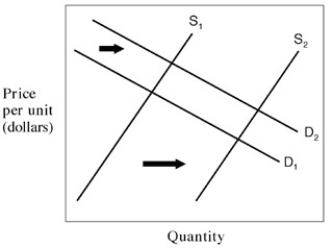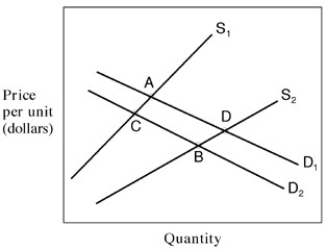A) exceed the external costs.
B) are less than the external costs.
C) equal the external costs.
D) understate the true cost of producing the product.
E) overstate the true cost of producing the product.
Correct Answer

verified
Correct Answer
verified
True/False
An economic justification for government providing public goods and services is that many people can benefit regardless of whether they pay or not.
Correct Answer

verified
Correct Answer
verified
Multiple Choice
Exhibit 4-3 Demand and supply curves
 -If the market demand and supply curves shift as given in Exhibit 4-3,the resulting new equilibrium will show a/an:
-If the market demand and supply curves shift as given in Exhibit 4-3,the resulting new equilibrium will show a/an:
A) increase in market price and a decrease in the quantity exchanged.
B) decrease in market price and a decrease in the quantity exchanged.
C) increase in market price and an increase in the quantity exchanged.
D) decrease in market price and an increase in the quantity exchanged.
E) decrease in market price and no change in the quantity exchanged.
Correct Answer

verified
Correct Answer
verified
Multiple Choice
If the government imposes a price ceiling above the market equilibrium price,then:
A) there will be excess supply.
B) there will be excess demand.
C) the market equilibrium price will prevail.
D) the price set by the government will prevail.
Correct Answer

verified
Correct Answer
verified
Multiple Choice
Suppose the government sets a price floor of $10.It means that the government:
A) wants to prevent market price from rising above $10.
B) wants to prevent market price from falling below $10.
C) has no intentions to intervene in the market.
D) wants a market to determine the market price.
Correct Answer

verified
Correct Answer
verified
Multiple Choice
When there is market failure due to a negative externality:
A) there are no way of correcting it.
B) setting price equal to marginal social cost will solve it.
C) the free market produces output at a too high price.
D) externalities have been taken into account.
E) the best solution eliminates the externality entirely.
Correct Answer

verified
Correct Answer
verified
Multiple Choice
A vaccination shot provides a/an:
A) beneficial opportunity cost.
B) positive externality.
C) out-resourcing benefit.
D) managed-care opportunity benefit.
Correct Answer

verified
Correct Answer
verified
True/False
More information on the benefits of honey will result in more honey bought.
Correct Answer

verified
Correct Answer
verified
Multiple Choice
There was an extensive black market (illegal market) for many consumer products in the United States during the Second World War.A likely explanation of the black market is that:
A) the prices of goods were artificially held down by price controls.
B) black markets were legal during the war.
C) goods were not subject to price controls.
D) gasoline rationing greatly restricted civilians from driving to stores.
Correct Answer

verified
Correct Answer
verified
Multiple Choice
Exhibit 4-4 Demand and supply curves
 -In Exhibit 4-4,a movement from A to B is best explained by:
-In Exhibit 4-4,a movement from A to B is best explained by:
A) an increase in income and in the number of suppliers.
B) an increase in the price of complements and an increase in the price of inputs.
C) an increase in income and a decrease in the number of producers.
D) a decrease in income and an improvement in the technology used to produce the good.
E) an increase in the number of suppliers and a decrease in price of substitutes.
Correct Answer

verified
Correct Answer
verified
Multiple Choice
The shortage occurs because:
A) the quantity supplied is more than the quantity demanded at this price.
B) of the black market.
C) the quantity supplied is less than the quantity demanded at this price.
D) the price floor was set by the government.
Correct Answer

verified
Correct Answer
verified
Multiple Choice
Consider the market for grapes.An increase in the wage paid to grape pickers will cause the:
A) demand curve for grapes to shift to the right, resulting in a higher equilibrium price for grapes and a reduction in the quantity consumed.
B) demand curve for grapes to shift to the left, resulting in a lower equilibrium price for grapes and an increase in the quantity consumed.
C) supply curve for grapes to shift to the left, resulting in a lower equilibrium price for grapes and a decrease in the quantity consumed.
D) supply curve for grapes to shift to the left, resulting in a higher equilibrium price for grapes and a decrease in the quantity consumed.
Correct Answer

verified
Correct Answer
verified
Multiple Choice
What are the effects of shifts in demand on market equilibrium?
A) Decrease in demand will result in higher equilibrium price and lower equilibrium quantity.
B) Decrease in demand will result in lower equilibrium price and lower equilibrium quantity.
C) Decrease in demand will result in higher equilibrium price and higher equilibrium quantity.
D) Decrease in demand will result in the same equilibrium price and equilibrium quantity.
Correct Answer

verified
Correct Answer
verified
Multiple Choice
Exhibit 4-5 Supply and demand data for cars
 -In Exhibit 4-5,assume that the government initially sets a price floor of $30 000 for cars,and then removes this price floor.What effect will this price change have?
-In Exhibit 4-5,assume that the government initially sets a price floor of $30 000 for cars,and then removes this price floor.What effect will this price change have?
A) The price of cars will rise.
B) The quantity of cars demanded will fall.
C) The quantity of cars supplied will decline.
D) Quantity supplied will continue to exceed quantity demanded.
Correct Answer

verified
Correct Answer
verified
True/False
Assuming supply is held constant,an increase in demand for a product will cause a decrease in the market price and the amount bought and sold.
Correct Answer

verified
Correct Answer
verified
Multiple Choice
Ethical considerations mean that there is a support for a policy of:
A) increasing taxes to lower income earners.
B) reducing taxes to higher income earners.
C) reducing income inequality below the equilibrium level.
D) reducing income inequality above the equilibrium level.
Correct Answer

verified
Correct Answer
verified
Multiple Choice
If the government imposes a price ceiling below the market equilibrium price,then:
A) there will be no changes to the market equilibrium.
B) there will be excess supply.
C) there will be more goods to meet the additional demand.
D) there will be less goods to meet the demand.
Correct Answer

verified
Correct Answer
verified
Multiple Choice
An externality is:
A) always a benefit to the recipient.
B) always a detriment to the recipient.
C) an activity that occurs in a business which is unknown to management.
D) an unintended benefit or cost imposed on third parties as a result of economic activity.
E) an act, caused by a firm located in this country, which has an effect on a person in a foreign country.
Correct Answer

verified
Correct Answer
verified
Multiple Choice
There are apartments in Perth whose rooftops overlook Subiaco Oval.On game day you can find free riders on the roof enjoying _____.
A) beer
B) free property rights
C) an externality
D) a public good
E) excess utility
Correct Answer

verified
Correct Answer
verified
Multiple Choice
Ceteris paribus,an increase in the supply of a good causes which of the following?
A) Lowers the equilibrium price and reduces the quantity bought and sold.
B) Raises the equilibrium price and raises the quantity bought and sold.
C) Raises the equilibrium price and increases the quantity bought and sold.
D) Lowers the equilibrium price and increases the quantity bought and sold.
E) Equilibrium price and equilibrium quantity change are indeterminate.
Correct Answer

verified
Correct Answer
verified
Showing 21 - 40 of 123
Related Exams